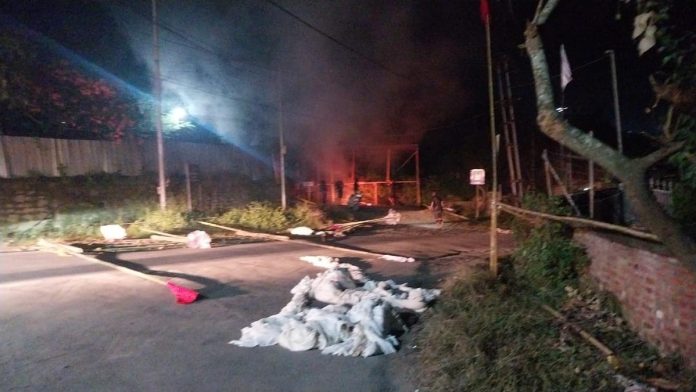 – Ranjan Solomon
– Ranjan Solomon
Prime Minister Narendra Modi’s proposed visit to Manipur – his first since ethnic violence erupted on May 3, 2023 – comes at a critical juncture. For over two years, the state has burned in cycles of brutality, distrust, and paralysis. In those dreadful months of killings, lootings, and torchings, the people grew conflict-weary, their wounds deepened by Delhi’s silence.
Now, tentative talk of peace has emerged. But fragments of mistrust remain scattered, and stitching them back will require patience, reconciliation, and justice. The question is whether Modi comes to Manipur with a genuine commitment to healing, or simply a bundle of announcements and slogans. The people have waited too long for answers.
Two Years of Silence
The government’s early response set the tone for failure. When violence broke out between Meiteis in the valley and Kuki-Zo tribals in the hills, the state’s duty was to protect lives impartially. Instead, Chief Minister N. Biren Singh allowed armed militias like the Arambai Tenggol and Meitei Leepun to operate unchecked. The Centre, rather than imposing President’s Rule, left the crisis to a partisan government.
Home Minister Amit Shah’s visits focused on weapons and law-and-order. But the deeper questions – why armed groups had space to act, why tribals felt abandoned – went unasked. Only when the horrific video of two young women being paraded naked went viral did Manipur become unavoidable national news.
By the time President’s Rule was imposed in February 2025, it looked more like face-saving than serious governance. Too much blood had been shed, and too much trust broken.
Broken Trust
Today, Manipur is a geography of barricaded identities. Torched homes stand in ruins; displaced families fear returning. Relief supplies often cannot cross ethnic lines. Communities describe each other with terms like “narco-terrorists”, deepening wounds and alienation.
Reconciliation cannot be built on symbolism alone. It must rest on justice – accountability for atrocities, acknowledgement of pain, and recognition of the rights of all communities.
Fault Lines
The conflict is rooted in long-standing asymmetries:
Political imbalance: Out of 60 Assembly seats, Meitei-dominated areas hold 40, while Nagas and Kukis share 20. Hill communities feel excluded from power and development.
Land and identity: Evictions from “reserved forests” and the push to include Meiteis in the Scheduled Tribe list ignited tribal fears of dispossession.
Development disparities: The Centre has promised security and ceasefires, but development funds remain valley-centric, leaving the hills impoverished and resentful.
Without addressing these, no peace deal will hold.
What Modi Faces
For two years, Modi avoided Manipur, leading many to conclude their suffering meant little in Delhi’s calculus. His visit now raises expectations but also scepticism. Will he treat Manipur as merely a law-and-order challenge, or as a profound political and ethical crisis?
If he comes only to announce mega projects and crores of investment, he will fail. Peace is not built by bypassing the wounds of justice. Unless funds, institutions, and opportunities genuinely reach the hills, demands for Separate Administration will not fade. Unless valley dominance gives way to more balanced representation, tribal voices will remain unheard.
Beyond Optics
Resources add another layer of complexity. The Kuki-inhabited hills are rich in coal, limestone, petroleum, and natural gas. Many believe these resources sharpen competition and even fuel conflict. If Modi seeks to brush these suspicions aside in favour of corporate or political interests, the distrust will deepen.
Grandstanding will get him nowhere. Reconciliation requires humility – including acknowledging the BJP’s failures. Modi must apologise for his absence while Manipur burned. He jetted off to the USA at the height of the crisis but did not make time for Manipur. Words of regret and a pledge of fairness are necessary starting points.
Amit Shah’s law-and-order approach cannot substitute for sensitive political mediation. This is not his forte, nor Modi’s natural instinct. Yet Modi has the political clout to commission a credible mediation process. An eminent person, or a team trusted by all sides, should be appointed to shepherd reconciliation and dialogue. That would signal seriousness, not tokenism.
No Quick Fix
Manipur is not waiting for a magic wand. Its people want recognition of pain, concrete steps toward equality, and an end to the culture of impunity. Relief camps must be safely emptied, free movement restored, and civil society given space to heal the divides.
Above all, the state requires a Truth and Reconciliation process – one that obliges fairness, accountability, and some give-and-take from all sides. This cannot be achieved through development announcements alone. It demands justice, empathy, and moral courage.
If Modi comes only with optics and grand speeches, he will leave Manipur unchanged, its wounds festering. But if he comes with humility and resolve, and if Delhi commissions genuine political mediation rooted in justice, he could begin the slow work of rebuilding trust.
The people of Manipur are not asking for miracles. They are asking for dignity, fairness, and peace – not as charity, but as their right.
[Ranjan Solomon is a political commentator and human rights defender]




